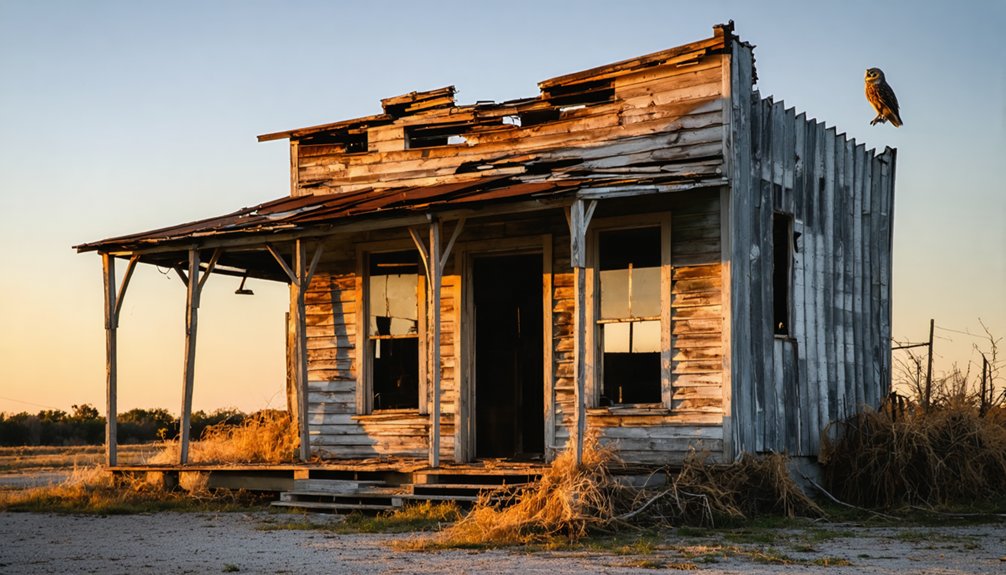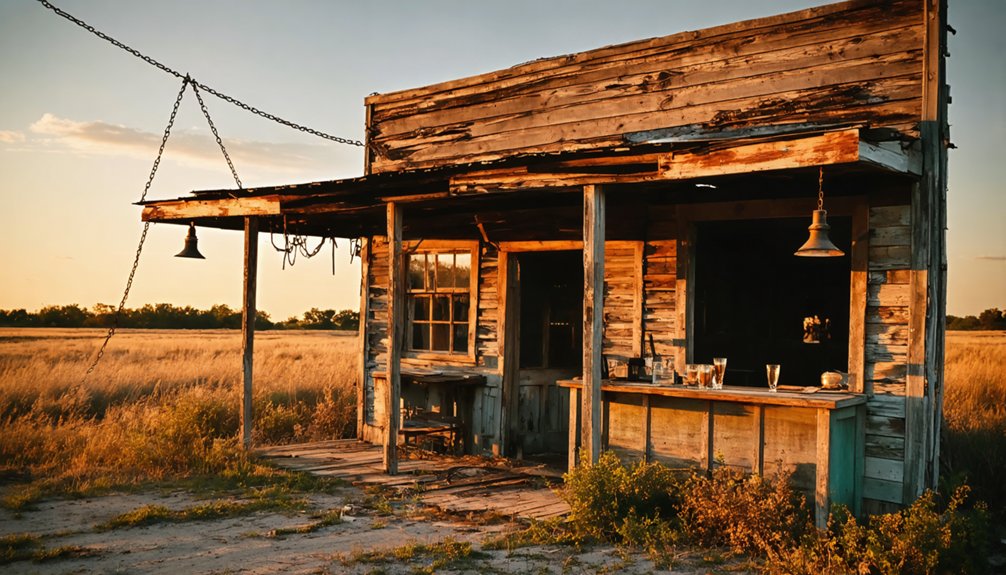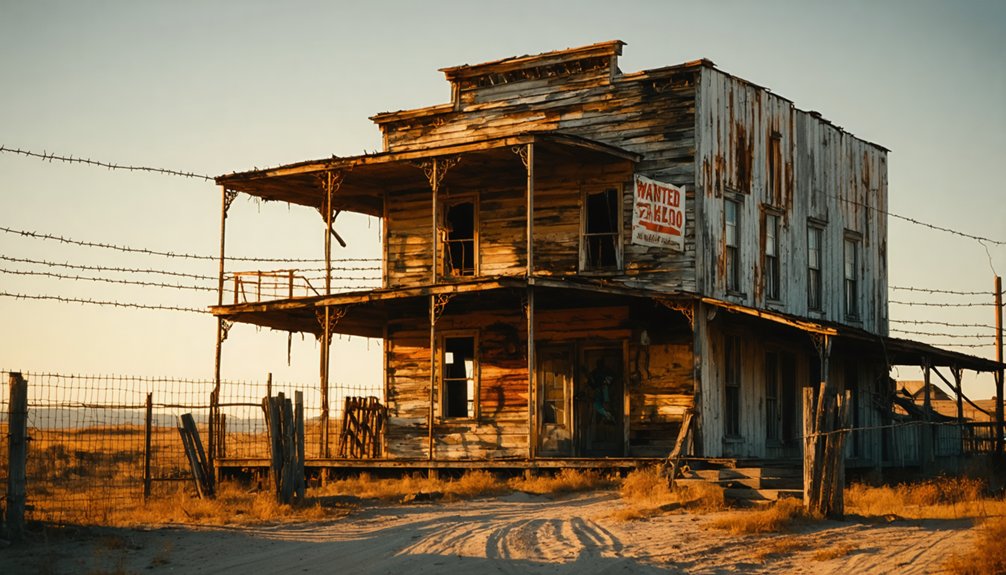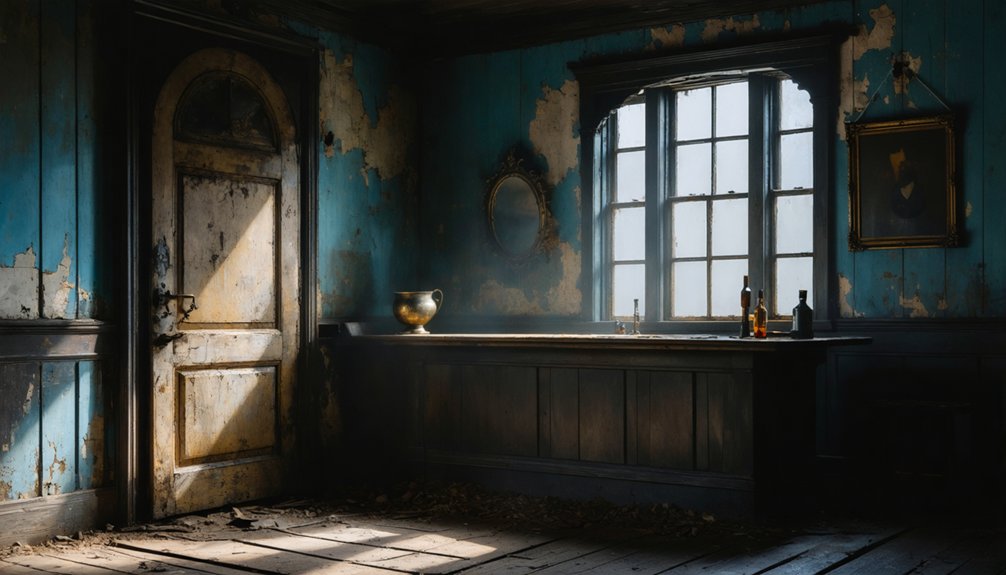Texas boasts 511 documented ghost towns, more than any other state. You’ll encounter haunting stories at Toyah High School, where spectral whispers echo through abandoned hallways, or Medicine Mound, where sacred Comanche healing rituals still occur. Once-thriving communities like Belle Plain College and St. Mary’s of Aransas succumbed to economic forces, railway bypasses, and devastating hurricanes. These forgotten settlements reveal the harsh realities of boom-and-bust cycles that shaped the Lone Star State’s complex history.
Key Takeaways
- Urban explorers at Toyah High School report ghostly whispers and eerie spectral sightings dating back to violent gun battles of 1882.
- Medicine Mound’s sacred hills, once a spiritual epicenter for Comanche healing ceremonies, still host annual traditions with spirit sticks and sage blessings.
- Belle Plain College stands as a haunting reminder of ambitious dreams crushed by railway diversions and devastating drought.
- St. Mary’s of Aransas, a once-thriving port rival to Galveston, was completely obliterated by two consecutive hurricanes in 1886-1887.
- Texas boasts 511 documented ghost towns, each telling unique stories of boom-and-bust cycles, abandoned dreams, and spectral remnants.
What Makes Texas the Ghost Town Capital of America
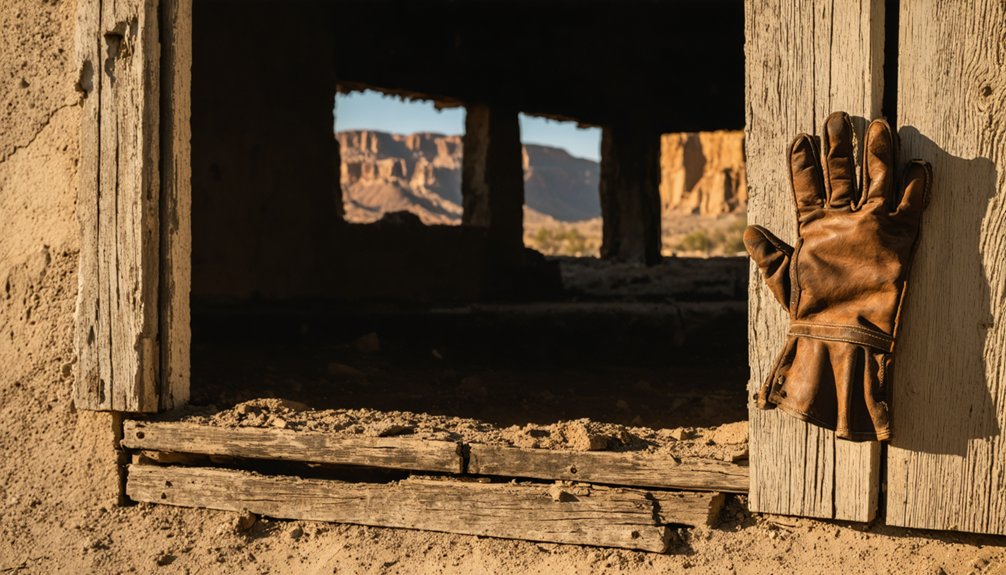
With a staggering 511 documented ghost towns, Texas easily claims the title of America’s ghost town capital, far outpacing California’s 346 and Kansas’s 308 abandoned settlements.
This remarkable concentration isn’t coincidental—it reflects Texas’s unique historical trajectory and shifting ghost town demographics over generations.
You’ll find these abandoned communities clustered throughout the state, with notable concentrations in the High Plains region and Wilson County, where 31 ghost towns are documented alone.
Within 25 miles of New Braunfels, you can explore 25 different abandoned settlements, each telling a story of boom and bust.
San Antonio is considered central to ghost towns and serves as a hub for those interested in exploring these abandoned pieces of history.
The historical significance of Texas ghost towns provides a fascinating window into America’s developmental patterns—from railroad expansions and contractions to the devastating impact of the Dust Bowl and economic evolution.
Towns like Gomez demonstrate how railway development decisions can determine whether a settlement thrives or disappears, as seen when the South Plains and Santa Fe Railway bypassed it in favor of Brownfield.
The Rise and Fall of Belle Plain: A College Town Lost to Time
You’ll find it hard to imagine that Belle Plain College, with its impressive three-story stone structure and renowned music department featuring twelve grand pianos, once represented the pinnacle of higher education in West Texas before completely shuttering in 1892.
The college’s closure, precipitated by the devastating economic collapse of Belle Plain following the railway’s bypass and a catastrophic drought, effectively erased a promising educational legacy that had attracted students from across the region.
While historical records document the college’s abandonment, they make no mention of hurricane damage, suggesting that natural forces—though significant in the form of drought—did not include tropical storms in Belle Plain’s tragic demise.
Today, visitors seeking to explore these historical ruins face significant challenges as the remaining structures are located on private property and access is strictly controlled by owners concerned about preservation and safety due to dangerous features like hollow cisterns that have caused injuries to trespassers in the past.
Educational Legacy Erased
The erasure of Belle Plain College’s educational legacy stands as a poignant chapter in Texas frontier history, where ambitious academic dreams collided with harsh economic realities.
You can trace the educational decline through what was once a thriving institution. Imagine the vibrant campus with its military branch, where students in blue and gray uniforms marched, and the music department’s twelve grand pianos filling classrooms with melody.
The three-story stone building with its distinctive cupola represented frontier intellectual aspirations.
When you visit today, only weathered stone ruins remain, ghostly memories of West Texas’s pioneering academic venture. Originally founded in 1881 by Methodists, the institution reached its peak with nearly 300 students enrolled before its downfall. The college developed superior course studies with particular excellence in its music programs, drawing students from throughout the region. As drought ravaged the region in 1886-1887, the college struggled until its 1892 closure.
Without the railroad’s lifeblood, Belle Plain’s educational experiment ended, leaving only crumbling walls to tell its story.
Hurricane’s Deadly Impact
While no actual hurricane struck Belle Plain, the economic and environmental storm that devastated the settlement proved just as destructive as any natural disaster.
You can trace the town’s demise to the confluence of two catastrophic events: the Texas and Pacific Railway‘s decision to bypass Belle Plain for Baird, and the brutal 1886-1887 drought.
Like coastal devastation following a hurricane, these twin forces hollowed out the once-thriving community. The railway’s rerouting stripped Belle Plain of its commercial advantage, while drought destroyed its agricultural foundation. The town’s peak growth occurred around 1929 with 14 oil wells contributing to its economy. Belle Plain’s population dramatically declined from nearly a thousand inhabitants by 1878 to virtually nothing within a decade.
Haunted Hallways: The Spectral Students of Toyah High School

Standing proud yet ominous against the West Texas horizon, Toyah High School‘s brick facade has silently witnessed over a century of history since its 1912 construction.
You’ll notice the dates still marked over doorways of this abandoned educational relic, now a shell of its former self after losing its top floor during a 1960s gymnasium conversion.
As you approach, the building’s connection to Toyah’s violent past becomes palpable. The town’s deadly 1882 gun battles involving Texas Rangers have seemingly imprinted themselves in these walls.
Urban explorers report ghostly whispers echoing through empty corridors and spectral sightings that defy explanation. The basement’s old basketball court and vintage appliances tell stories of bygone school days. The severe April 2004 flooding caused additional damage to the already decaying structure, leaving behind watermarks that some say resemble spectral figures. The structure’s prominence from the highway beckons the curious to experience its uniquely chilling atmosphere, especially after nightfall.
Medicine Mound: Sacred Hills and Abandoned Dreams
You’ll discover Medicine Mound’s four sacred conical hills where Comanche people once performed healing ceremonies and spiritual rituals long before settlers arrived.
The town’s transformation into a thriving commercial center with 22 businesses by 1929 represented the hopeful aspirations of early 20th-century pioneers.
The railroad-initiated prosperity proved tragically short-lived, as economic depression, Ella Tidmore’s devastating 1933 fire, and harsh weather ultimately reduced this once-promising community to cobblestone ruins that stand as silent witnesses to abandoned dreams.
Sacred Comanche Rituals
Nestled among the rolling plains of southeastern Hardeman County, the four dolomite mounds of Medicine Mound served as the spiritual epicenter of Comanche religious practices for centuries.
You’ll find the essence of Comanche sacred ceremonies in their vision quests, where warriors fasted for days before ascending the largest mound to seek spiritual guidance. At the summit, they’d meditate until receiving visions from the benevolent spirit believed to inhabit the flat-capped peak.
The mounds’ unique ecosystem provided rare healing plants that Comanche healers mixed with mineral waters for powerful medicine.
Even Quanah Parker, the last great Comanche chief, sought spiritual renewal here.
Today, despite needing permission to access their ancestral grounds, Comanche descendants continue spiritual healing traditions, placing spirit sticks for deceased relatives and performing cedar smoke and sage blessings during annual ceremonies.
Fading Commercial Hub
While the Medicine Mounds had served as sacred grounds for the Comanche people for centuries, the ambitious Kansas, Mexico and Orient Railroad Company transformed the nearby plains into a bustling commercial hub when they extended their rail line to the area in 1909.
By 1929, this fading commerce center boasted 500 residents and 22 thriving businesses, a reflection of America’s railroad-driven expansion.
The dream collapsed rapidly. The 1929 stock market crash, followed by devastating drought and dust storms, crippled the agricultural foundation of the community.
Then came the catastrophic 1933 fire, which consumed nearly all structures at 3 a.m. on March 31st. Among towns forgotten in America’s march toward industrialization, Medicine Mound’s demise was particularly swift.
Terlingua’s Remarkable Resurrection From Mining Bust
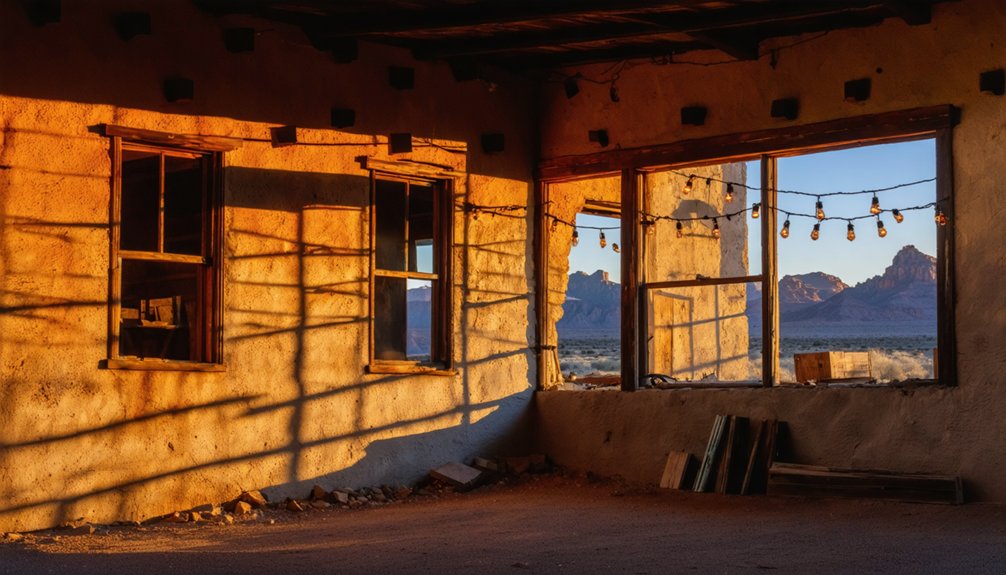
Following the bankruptcy of the Chisos Mining Company in 1942 and the complete abandonment of mining operations by 1946, Terlingua’s transformation from forgotten ruin to cultural attraction stands as one of the most fascinating resurrections in Texas ghost town history.
When you visit today, you’ll walk among the limestone and adobe skeletons of what was once America’s mercury mining powerhouse. The Terlingua history preserved in these structures tells the tale of a community that once supplied 40% of the nation’s quicksilver and housed 2,000 residents during its 1910s-1920s heyday.
After artesian flooding and post-war market collapse emptied the town, the mining heritage remained frozen in time. Now positioned strategically near Big Bend National Park, Terlingua has found new purpose as a living museum where you can experience the authentic remnants of Texas’ boom-and-bust mining legacy.
St. Mary’s of Aransas: The Port City That Vanished
When you stand today at the windswept shores of Copano Bay where St. Mary’s of Aransas once stood, you’re walking through a haunting history of boom and bust.
This once-thriving port rivaled Galveston, housing 5,000 residents between 1850 and 1886. You’d hardly believe this empty landscape contained two hotels, a brickyard, and steamship connections to major Texas ports.
The town’s cultural significance can’t be overstated—it birthed South Texas’ first newspaper, first college, and Clara Driscoll, the “Savior of the Alamo.”
Civil War capture by Union forces began St. Mary’s decline, but nature delivered the final blow. Two devastating hurricanes in 1886-87 obliterated nearly everything.
Economic Forces That Created Texas Ghost Towns
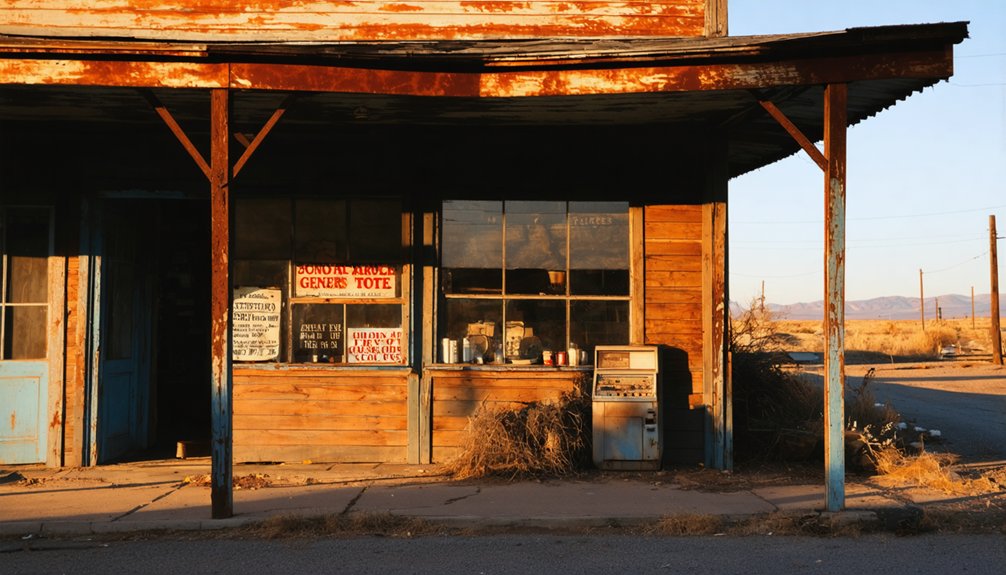
Unlike St. Mary’s which fell to natural forces, most Texas ghost towns succumbed to economic shifts.
You’ll find that transportation changes dramatically altered the state’s landscape—communities that secured railroad stops thrived while others withered, with entire towns relocating to survive near railway lines.
The boom-and-bust cycle of resource extraction claimed over 500 towns.
Oil discoveries created overnight boomtowns like Best and Moonshine Hill, abandoned when wells dried up.
Mining communities such as Shafter collapsed when silver demand plummeted, transforming “the richest acre in Texas” into abandoned ruins.
Agricultural communities faced dual devastation from the 1930s Dust Bowl and mechanization, reducing labor needs.
More recently, highway diversions and service closures sealed the fate of struggling towns like Mentone, whose population plummeted from 600 to just 19 residents today.
Exploring the Eerie Remnants of Hagerman
Among Texas’ submerged ghost towns, Hagerman presents perhaps the most haunting narrative of community sacrifice for infrastructure development. When you visit today, you’ll discover a place where Hagerman history lies beneath Lake Texoma’s waters, abandoned in 1942 as the Denison Dam’s completion loomed.
During droughts, ghostly remnants of this once-thriving agricultural community emerge from the depths:
- The preserved church and cemetery standing as silent sentinels above the waterline
- Exposed foundations and structural remnants when lake levels drop
- The original cemetery located miles from the submerged townsite
- Artifacts occasionally resurfacing, providing glimpses into 1870s pioneer life
What you’re witnessing isn’t merely abandonment, but a community deliberately sacrificed for regional development—83,000 acres submerged, including most of a vibrant town.
Planning Your Ghost Town Road Trip Through Texas

Starting a ghost town road trip through Texas requires careful planning, as the state’s vast landscape harbors over 300 documented abandoned settlements scattered across diverse geographical regions.
You’ll benefit from interactive maps like BurningCompass and Forgotten Lands that provide coordinates and historical context for efficient route planning.
Consider clustering destinations by region—Panhandle, Hill Country, East Texas, or South Texas—to maximize your exploration efficiency.
Be mindful of accessibility challenges; many remote sites require 4WD vehicles and offline maps due to limited cellular coverage.
Research each location’s historical significance beforehand, noting causes of abandonment like railroad relocations or mining busts.
Always prioritize ghost town preservation by respecting private property boundaries and staying on marked paths.
Pack emergency supplies when venturing to isolated areas, and coordinate with local historical societies for enhanced experiences.
Frequently Asked Questions
Are Children Allowed on Ghost Town Tours?
While ensuring children’s safety remains paramount, you’ll find most Texas ghost town tours welcome young visitors. Many operators offer family-friendly tours with age-appropriate content, though specific restrictions vary between companies.
Do Any Ghost Towns Host Overnight Accommodation Options?
You’ll discover abundant ghost town lodging options in Terlingua, from luxury yurts to historic casitas. These paranormal stays offer comfortable amenities while preserving the haunting atmosphere of Texas’s mining past.
What Paranormal Equipment Is Permitted During Ghost Town Visits?
Like moths drawn to spectral flames, you’ll find ghost hunting equipment guidelines vary by location. You’re typically allowed basic tools—EMF meters, cameras, and audio recorders—but advanced equipment may require prior permission.
Can Visitors Collect Artifacts Found in Ghost Towns?
You can’t legally collect artifacts on federal or state lands. Ghost town regulations prioritize artifact preservation, requiring written permission on private property and proper permits for any collection activities.
Are There Seasonal Differences in Ghost Town Accessibility?
Yes, you’ll encounter significant seasonal weather variations affecting ghost town accessibility. Summer brings extreme heat while winter presents occasional ice, and spring/fall offer ideal exploration conditions with fewer accessibility challenges.
References
- https://en.wikipedia.org/wiki/List_of_ghost_towns_in_Texas
- https://texashighways.com/travel-news/four-texas-ghost-towns/
- https://www.hipcamp.com/journal/camping/texas-ghost-towns/
- https://www.county.org/county-magazine-articles/summer-2025/ghost-towns
- https://www.youtube.com/watch?v=Zd8-gKw-5Hc
- https://freepages.history.rootsweb.com/~gtusa/usa/tx.htm
- https://www.texasescapes.com/TOWNS/Texas_ghost_towns.htm
- https://mix931fm.com/texas-ghost-towns-history/
- https://tpwmagazine.com/archive/2018/jan/wanderlist_ghosttowns/
- https://700wlw.iheart.com/content/2018-10-31-texas-is-1-in-ghost-towns/
